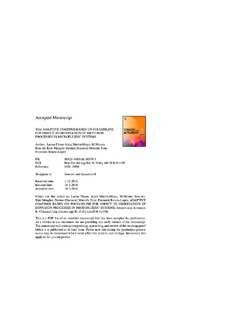Izenburua
Adaptive coatings based on polyaniline for direct 2D observation of diffusion processes in microfluidic systemsEgilea (beste erakunde batekoa)
Beste instituzio
Dublin City UniversityIkerbasque
Universidad del País Vasco/Euskal Herriko Unibertsitatea (UPV/EHU)
Bertsioa
Postprinta
Eskubideak
© 2016 Elsevier B.V. All rights reserved.Sarbidea
Sarbide irekiaArgitaratzailearen bertsioa
http://dx.doi.org/10.1016/j.snb.2016.03.085Non argitaratua
Sensors and Actuators B: Chemical Vol. 231. Pp. 744-751. August, 2016Lehenengo orria
744Azken orria
751Argitaratzailea
ElsevierGako-hitzak
Polyaniline
Mixing process
Adaptive coatings
Optical sensor ... [+]
Mixing process
Adaptive coatings
Optical sensor ... [+]
Polyaniline
Mixing process
Adaptive coatings
Optical sensor
Microfluidics
Computational fluid dynamics
(CFD) [-]
Mixing process
Adaptive coatings
Optical sensor
Microfluidics
Computational fluid dynamics
(CFD) [-]
Laburpena
Microfluidic devices are poised to dramatically influence the future of the process industry. Therefore the understanding and proper evaluation of the flow and mixing behaviour at microscale becomes a ... [+]
Microfluidic devices are poised to dramatically influence the future of the process industry. Therefore the understanding and proper evaluation of the flow and mixing behaviour at microscale becomes a very important issue. In this study, the diffusion behaviour of two reacting solutions of HCl and NaOH were directly observed in a glass/polydimethylsiloxane microfluidic device using adaptive coatings based on the conductive polymer polyaniline that are covalently attached to the microchannel walls. The two liquid streams were combined at the junction of a Y-shaped microchannel, and allowed to diffuse into each other and react. The results showed excellent correlation between optical observation of the diffusion process and the numerical results. A numerical model which is based on finite volume method (FVM) discretisation of steady Navier-Stokes (fluid flow) equations and mass transport equations without reactions was used to calculate the flow variables at discrete points in the finite volume mesh element. The high correlation between theory and practical data indicates the potential of such coatings to monitor diffusion processes and mixing behaviour inside microfluidic channels in a dye free environment. [-]






















